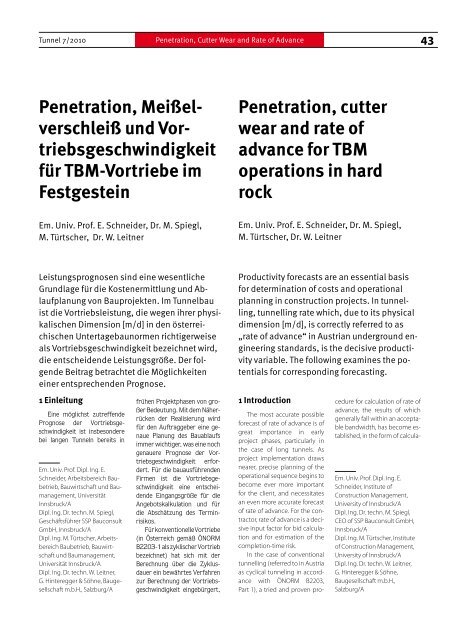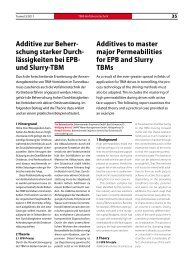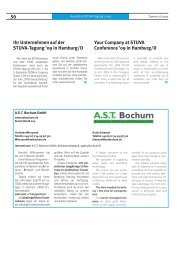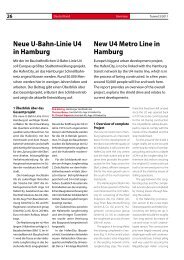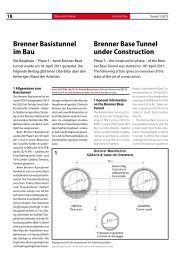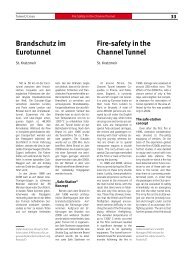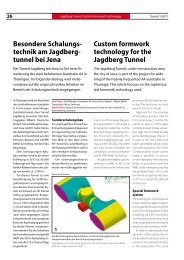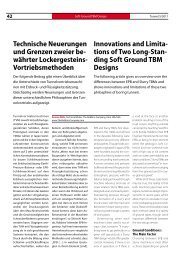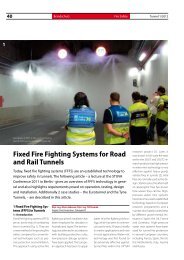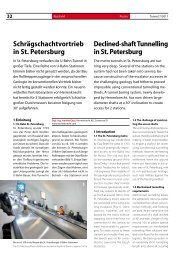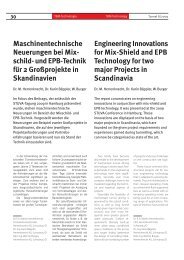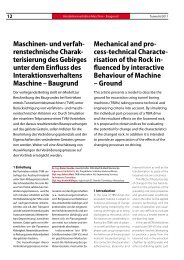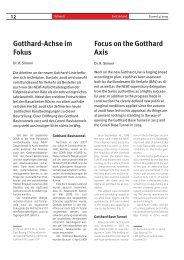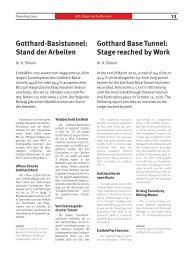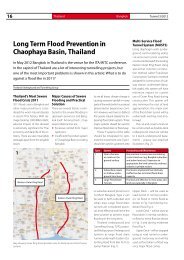Penetration, Meißel- verschleiß und Vor ... - Tunnel
Penetration, Meißel- verschleiß und Vor ... - Tunnel
Penetration, Meißel- verschleiß und Vor ... - Tunnel
Erfolgreiche ePaper selbst erstellen
Machen Sie aus Ihren PDF Publikationen ein blätterbares Flipbook mit unserer einzigartigen Google optimierten e-Paper Software.
<strong>Tunnel</strong> 7/2010 <strong>Penetration</strong>, Cutter Wear and Rate of Advance<br />
43<br />
<strong>Penetration</strong>, <strong>Meißel</strong><strong>verschleiß</strong><br />
<strong>und</strong> <strong>Vor</strong>triebsgeschwindigkeit<br />
für TBM-<strong>Vor</strong>triebe im<br />
Festgestein<br />
Em. Univ. Prof. E. Schneider, Dr. M. Spiegl,<br />
M. Türtscher, Dr. W. Leitner<br />
Leistungsprognosen sind eine wesentliche<br />
Gr<strong>und</strong>lage für die Kostenermittlung <strong>und</strong> Ablaufplanung<br />
von Bauprojekten. Im <strong>Tunnel</strong>bau<br />
ist die <strong>Vor</strong>triebsleistung, die wegen ihrer physikalischen<br />
Dimension [m/d] in den österreichischen<br />
Untertagebaunormen richtigerweise<br />
als <strong>Vor</strong>triebsgeschwindigkeit bezeichnet wird,<br />
die entscheidende Leistungsgröße. Der folgende<br />
Beitrag betrachtet die Möglichkeiten<br />
einer entsprechenden Prognose.<br />
1 Einleitung<br />
Eine möglichst zutreffende<br />
Prognose der <strong>Vor</strong>triebsgeschwindigkeit<br />
ist insbesondere<br />
bei langen <strong>Tunnel</strong>n bereits in<br />
Em. Univ. Prof. Dipl. Ing. E.<br />
Schneider, Arbeitsbereich Baubetrieb,<br />
Bauwirtschaft <strong>und</strong> Baumanagement,<br />
Universität<br />
Innsbruck/A<br />
Dipl. Ing. Dr. techn. M. Spiegl,<br />
Geschäftsführer SSP Bauconsult<br />
GmbH, Innsbruck/A<br />
Dipl. Ing. M. Türtscher, Arbeitsbereich<br />
Baubetrieb, Bauwirtschaft<br />
<strong>und</strong> Baumanagement,<br />
Universität Innsbruck/A<br />
Dipl. Ing. Dr. techn. W. Leitner,<br />
G. Hinteregger & Söhne, Baugesellschaft<br />
m.b.H., Salzburg/A<br />
frühen Projektphasen von großer<br />
Bedeutung. Mit dem Näherrücken<br />
der Realisierung wird<br />
für den Auftraggeber eine genaue<br />
Planung des Bauablaufs<br />
immer wichtiger, was eine noch<br />
genauere Prognose der <strong>Vor</strong>triebsgeschwindigkeiterfordert.<br />
Für die bauausführenden<br />
Firmen ist die <strong>Vor</strong>triebsgeschwindigkeit<br />
eine entscheidende<br />
Eingangsgröße für die<br />
Angebotskalkulation <strong>und</strong> für<br />
die Abschätzung des Termin-<br />
risikos.<br />
Für konventionelle <strong>Vor</strong>triebe<br />
(in Österreich gemäß ÖNORM<br />
B2203-1 als zyklischer <strong>Vor</strong>trieb<br />
bezeichnet) hat sich mit der<br />
Berechnung über die Zyklusdauer<br />
ein bewährtes Verfahren<br />
zur Berechnung der <strong>Vor</strong>triebsgeschwindigkeit<br />
eingebürgert,<br />
<strong>Penetration</strong>, cutter<br />
wear and rate of<br />
advance for TBM<br />
operations in hard<br />
rock<br />
Em. Univ. Prof. E. Schneider, Dr. M. Spiegl,<br />
M. Türtscher, Dr. W. Leitner<br />
Productivity forecasts are an essential basis<br />
for determination of costs and operational<br />
planning in construction projects. In tunnelling,<br />
tunnelling rate which, due to its physical<br />
dimension [m/d], is correctly referred to as<br />
„rate of advance“ in Austrian <strong>und</strong>ergro<strong>und</strong> engineering<br />
standards, is the decisive productivity<br />
variable. The following examines the potentials<br />
for corresponding forecasting.<br />
1 Introduction<br />
The most accurate possible<br />
forecast of rate of advance is of<br />
great importance in early<br />
project phases, particularly in<br />
the case of long tunnels. As<br />
project implementation draws<br />
nearer, precise planning of the<br />
operational sequence begins to<br />
become ever more important<br />
for the client, and necessitates<br />
an even more accurate forecast<br />
of rate of advance. For the contractor,<br />
rate of advance is a decisive<br />
input factor for bid calculation<br />
and for estimation of the<br />
completion-time risk.<br />
In the case of conventional<br />
tunnelling (referred to in Austria<br />
as cyclical tunneling in accordance<br />
with ÖNORM B2203,<br />
Part 1), a tried and proven pro-<br />
cedure for calculation of rate of<br />
advance, the results of which<br />
generally fall within an acceptable<br />
bandwidth, has become established,<br />
in the form of calcula-<br />
Em. Univ. Prof. Dipl. Ing. E.<br />
Schneider, Institute of<br />
Construction Management,<br />
University of Innsbruck/A<br />
Dipl. Ing. Dr. techn. M. Spiegl,<br />
CEO of SSP Bauconsult GmbH,<br />
Innsbruck/A<br />
Dipl. Ing. M. Türtscher, Institute<br />
of Construction Management,<br />
University of Innsbruck/A<br />
Dipl. Ing. Dr. techn. W. Leitner,<br />
G. Hinteregger & Söhne,<br />
Baugesellschaft m.b.H.,<br />
Salzburg/A
44<br />
TBM-<strong>Vor</strong>trieb TBM Operation<br />
1 Von der <strong>Penetration</strong> zur <strong>Vor</strong>triebsleistung 1 From penetration to rate of advance<br />
dessen Ergebnisse im Allgemeinen<br />
innerhalb einer akzeptablen<br />
Bandbreite liegen. Für maschinelle<br />
<strong>Vor</strong>triebe (in Österreich<br />
gemäß ÖNORM B2203-2 als<br />
kontinuierlicher <strong>Vor</strong>trieb bezeichnet)<br />
konnte sich bisher<br />
kein Standardberechnungsverfahren<br />
etablieren.<br />
Wie bei Submissionen festgestellt<br />
werden kann, liegen die<br />
von den Bietern prognostizierten<strong>Vor</strong>triebsgeschwindigkeiten<br />
teilweise weit auseinander.<br />
Ähnlich verhält es sich mit den<br />
tatsächlich erzielten <strong>Vor</strong>triebsgeschwindigkeiten,<br />
die oft erheblich<br />
von den prognostizierten<br />
Werten abweichen. Diese<br />
Situation, die Lok Home (Präsident,<br />
The Robbins Company,<br />
USA) mit den Worten „Tolerance<br />
of innacurate estimations is<br />
hurting our industry“ kritisiert<br />
[1], ist für alle Projektbeteiligten<br />
äußerst unbefriedigend. Im<br />
Folgenden werden die Ursachen<br />
für diesen Zustand untersucht<br />
<strong>und</strong> ein Berechnungsverfahren<br />
vorgestellt, das zu besseren<br />
Ergebnissen führt.<br />
2 Gr<strong>und</strong>lagen<br />
Um <strong>Vor</strong>triebsleistungen für<br />
<strong>Tunnel</strong>bohrmaschinen in einer<br />
gegebenen Geologie berechnen<br />
zu können, muss zunächst die<br />
<strong>Penetration</strong>, ausgedrückt in<br />
mm <strong>Vor</strong>trieb pro Bohrkopfumdrehung,<br />
ermittelt werden.<br />
Der nächste Schritt führt zur<br />
Nettobohrgeschwindigkeit, angegeben<br />
in m/h. Dazu wird die<br />
<strong>Penetration</strong> multipliziert mit<br />
der Drehzahl des Bohrkopfs –<br />
angegeben in Umdrehungen<br />
pro Minute – multipliziert mit<br />
60 Sek<strong>und</strong>en dividiert durch<br />
1000 mm.<br />
Im nächsten Berechnungsschritt,<br />
der von der Nettobohrgeschwindigkeit<br />
zur <strong>Vor</strong>triebsgeschwindigkeit<br />
führt, müssen<br />
die Behinderungen, Störungen<br />
<strong>und</strong> Unterbrechungen des Bohrbetriebs<br />
berücksichtigt werden.<br />
Dies geschieht in vielen Fällen<br />
durch Multiplikation der Nettoleistung<br />
mit einem Ausnutzungsgrad<br />
[%], bei genauerer<br />
Berechnung durch Ansetzen<br />
von Stillstandszeiten in Minuten<br />
oder St<strong>und</strong>en.<br />
Als weiterer Faktor muss die<br />
<strong>Vor</strong>triebszeit, das ist die für den<br />
<strong>Vor</strong>trieb zur Verfügung stehende<br />
Arbeitszeit, in die Berechnung<br />
einfließen. Diese beträgt maximal<br />
24 St<strong>und</strong>en pro Arbeitstag.<br />
Wenn eine regelmäßige Wartungsschicht<br />
vorgesehen ist<br />
oder das Arbeitszeitmodell keinen<br />
24-h-Betrieb erlaubt, beträgt<br />
die <strong>Vor</strong>triebszeit entsprechend<br />
weniger.<br />
In Gesteinen mit einem hohen<br />
Anteil an abrasiven Mineralien<br />
spielt – zumindest in <strong>Tunnel</strong>n<br />
mit großem Durchmesser<br />
– der <strong>Meißel</strong><strong>verschleiß</strong> eine<br />
nicht zu unterschätzende Rolle.<br />
tion via the cycle time. In the<br />
case of TBM-based tunnelling<br />
(referred to in Austria as continuous<br />
tunnelling in accordance<br />
with ÖNORM B2203, Part 2), no<br />
standard calculation procedure<br />
has up to now become established.<br />
As can be observed from<br />
bids submitted, the rates of advance<br />
predicted by bidders in<br />
some cases diverge greatly. The<br />
same is also true of the rates of<br />
advance actually achieved,<br />
which frequently deviate significantly<br />
from the forecast figures.<br />
This situation, criticized by Lok<br />
Home (president of The Robbins<br />
Company, USA) in his words,<br />
„Tolerance of inaccurate estimations<br />
is hurting our industry“ [1]<br />
is most unsatisfactory for all<br />
those involved in the project.<br />
The causes of this situation are<br />
investigated below, and a calculation<br />
procedure which produces<br />
better results is examined.<br />
2 Basic principles<br />
It is necessary, in order to calculate<br />
tunnelling rates for tunnel<br />
boring machines (TBMs) in a<br />
given geology, to determine<br />
penetration, expressed in mm<br />
of advance per rotation of the<br />
cutter head.<br />
The first step produces net<br />
boring speed, stated in m/h. To<br />
obtain this, penetration is multiplied<br />
by the speed of rotation of<br />
<strong>Tunnel</strong> 7/2010<br />
the cutter head - stated in revolutions<br />
per minute (rpm) - multiplied<br />
by 60 (seconds) and divided<br />
by 1000 (mm).<br />
The next calculation operation,<br />
which leads from net boring<br />
speed to rate of advance,<br />
must take account of obstructions,<br />
faults and interruptions to<br />
tunneling. In many cases, this is<br />
accomplished by multiplying<br />
net boring speed by a utilization<br />
factor [%], and in more precise<br />
calculation, by means of the assumption<br />
of downtimes in minutes<br />
or hours.<br />
<strong>Tunnel</strong>ling time, i.e., the<br />
working time available for tunnelling,<br />
is another factor which<br />
must be included in the calculation.<br />
This, naturally, is a maximum<br />
of twenty-four hours per<br />
working day. <strong>Tunnel</strong>ing time is<br />
correspondingly lower in cases<br />
in which a regular maintenance<br />
shift is scheduled, or where the<br />
working-hours model does not<br />
permit 24 h operation.<br />
In strata containing a high<br />
abrasive-minerals content, cutter<br />
wear also plays a role which<br />
should not be <strong>und</strong>erestimated,<br />
at least in large-bore tunnels,<br />
since the tunnelling time available<br />
is automatically reduced as<br />
soon as the time available during<br />
the maintenance shift is no<br />
longer adequate for performance<br />
of all the necessary cutter<br />
changes. This situation becomes<br />
even more critical if it is
<strong>Tunnel</strong> 7/2010 <strong>Penetration</strong>, <strong>Meißel</strong><strong>verschleiß</strong> <strong>und</strong> <strong>Vor</strong>trieb<br />
45<br />
2 <strong>Vor</strong>triebszyklus einer TBM-S; Teilprozesse <strong>Vor</strong>trieb <strong>und</strong> Sicherung<br />
Sobald nämlich die in der<br />
Wartungsschicht zur Verfügung<br />
stehende Zeit nicht mehr ausreicht,<br />
um alle notwendigen<br />
<strong>Meißel</strong>wechsel durchzuführen,<br />
verringert sich automatisch die<br />
zur Verfügung stehende <strong>Vor</strong>triebszeit.<br />
Verschärft wird diese<br />
Situation, wenn während der<br />
<strong>Vor</strong>triebszeit zusätzliche <strong>Meißel</strong><br />
gewechselt werden müssen.<br />
Bei offenen TBM haben auch<br />
Menge <strong>und</strong> Art der im Arbeitsbereich<br />
A1 unmittelbar hinter<br />
dem Bohrkopf einzubauenden<br />
Stützmittel einen wesentlichen<br />
Einfluss auf die <strong>Vor</strong>triebsgeschwindigkeit.<br />
So bedingt<br />
Spritzbetoneinbau in diesem<br />
Bereich fast immer eine Unterbrechung<br />
des Bohrzyklus, während<br />
Anker, Baustahlgitter <strong>und</strong><br />
Firstkappen weitgehend parallel<br />
zum Bohrfortschritt eingebaut<br />
werden können.<br />
Darüber hinaus sind bei der<br />
Berechnung der <strong>Vor</strong>triebsge-<br />
schwindigkeit noch diverse maschinentechnische,baubetriebliche,<br />
logistische <strong>und</strong> organisa-<br />
torische Randbedingungen zu<br />
beachten. Die quantitative Berücksichtigung<br />
all dieser Parameter,<br />
Abhängigkeiten, Rückkoppelungen<br />
<strong>und</strong> Einflüsse ist<br />
nicht ganz einfach <strong>und</strong> – weil<br />
teilweise mehrere Iterationsschritte<br />
erforderlich sind – nur<br />
in einem komplexen Rechenmodell<br />
möglich. Bild 1 illustriert<br />
die Zusammenhänge.<br />
In der Praxis werden zur<br />
Berechnung der <strong>Vor</strong>triebsgeschwindigkeit<br />
meist vereinfachende<br />
Rechenmodelle verwendet,<br />
die nur die wesentlichen<br />
Zusammenhänge berücksichtigen.<br />
Auch gibt es viele Projekte,<br />
bei denen nicht alle für eine genaue<br />
Berechnung der <strong>Penetration</strong><br />
erforderlichen Kennwerte<br />
vorliegen. Erfahrene Anwender<br />
– insbesondere die im maschinellen<br />
<strong>Tunnel</strong>bau tätigen Baufirmen<br />
– können diese Mängel<br />
meist durch Erfahrung kompensieren.<br />
In Anbetracht des<br />
essentiellen Einflusses der <strong>Vor</strong>triebsgeschwindigkeit<br />
auf die<br />
Ausbruchpreise <strong>und</strong> auf die zeitgeb<strong>und</strong>enenBaustellengemeinkosten,<br />
aber auch weil die <strong>Vor</strong>triebsgeschwindigkeit<br />
in vielen<br />
Verträgen von den Unternehmern<br />
garantiert werden muss<br />
oder zumindest über die<br />
Terminschiene mit Vertragsstrafen<br />
belegt wird, ist dies ein<br />
hohes Risiko. Angeregt durch<br />
die Analyse vieler TBM-<strong>Vor</strong>triebe<br />
<strong>und</strong> angetrieben von dem<br />
Wunsch, eine bisher unbefriedigend<br />
gelöste Aufgabenstellung<br />
besser zu lösen, haben die Autoren<br />
ein neues Modell zur Be-<br />
rechnung der <strong>Vor</strong>triebsgeschwindigkeit<br />
erarbeitet <strong>und</strong><br />
dazu eine Software entwickelt,<br />
welche die komplexen Zusammenhänge<br />
berücksichtigt <strong>und</strong><br />
den Anwendern die komplizierten<br />
Rechenvorgänge <strong>und</strong> Iterationen<br />
abnimmt.<br />
3 Stand der Technik<br />
Für die Prognose der<br />
<strong>Penetration</strong> gibt es eine Vielzahl<br />
von Modellen, die unterschiedlich<br />
konzipiert sind <strong>und</strong> auf unterschiedlichen<br />
Erfahrungen<br />
beruhen. Die bekanntesten sind<br />
(aufgezählt nach dem Erscheinungsjahr<br />
der zuletzt erschienenen<br />
Publikation) das CSM-<br />
Modell (Colorado School of<br />
Mines, 1993), das Modell von<br />
Gehring (ehemaliger Leiter F&E<br />
Voest-Alpine Montantechnik,<br />
Zeltweg/A, 1995) <strong>und</strong> das<br />
NTNU-Modell (Norges teknisknaturvitenskapelige<br />
universitet<br />
2 The tunnelling cycle of a TBM-S; the tunneling and support sub-processes<br />
necessary to change additional<br />
cutters during tunneling time.<br />
In the case of open TBMs, the<br />
quantity and type of the support<br />
systems to be installed in<br />
Work Zone A1 immediately behind<br />
the cutter head also have a<br />
significant influence on rate of<br />
advance. Shotcreting in this<br />
zone, for example, virtually always<br />
necessitates interruption<br />
to the tunnelling cycle, whereas<br />
rock bolts, steel mesh and steel<br />
arches can largely be installed<br />
simultaneously to tunnelling<br />
advance.<br />
In addition, various machine,<br />
operational, logistical and organizational<br />
bo<strong>und</strong>ary conditions<br />
must also be taken into account<br />
in calculation of rate of<br />
advance. Quantitative inclusion<br />
of all these parameters, interdependencies,<br />
feedback interactions<br />
and influences is not entirely<br />
simple and is possible only<br />
in the context of a complex<br />
computation model, since multiple<br />
iterations are necessary in<br />
many cases. Fig. 1 illustrates the<br />
correlations.<br />
In practice, simplifying computation<br />
models, which take account<br />
only of the most essential<br />
correlations, are generally used<br />
for calculation of rate of advance.<br />
In addition, there are also<br />
many projects for which not all<br />
the characteristics data necessary<br />
for precise calculation of<br />
penetration are available.<br />
Experienced users, and contractors<br />
active in machine tunneling,<br />
in particular, are in most<br />
cases able to make good these<br />
deficiencies with their experience.<br />
This involves a high level<br />
of risk, however, in view of the<br />
critical influence of rate of advance<br />
on excavation costs and<br />
on time-dependent site over-<br />
heads, and also due to the fact<br />
that rate of advance must, in<br />
many project contracts, be guaranteed<br />
by the contractor, or is, at<br />
the least, subject to liquidated<br />
damages clauses via the agreed<br />
milestones. Stimulated by analysis<br />
of a large number of TBM<br />
projects, and motivated by the<br />
desire to find a better solution to<br />
a task which has, up to now, been<br />
solved only unsatisfactorily, the<br />
authors have developed a new<br />
model for the calculation of rate<br />
of advance and, for this model,<br />
software which takes due account<br />
of the complex correlations<br />
and relieves users of the<br />
complicated calculation procedures<br />
and multiple iterations<br />
otherwise necessary.<br />
3 The current state-ofthe-art<br />
There is a large number of<br />
models, of differing conception<br />
and based on differing experience,<br />
for forecasting of penetration.<br />
The best known of these<br />
are (in order of the year of the<br />
most recent publications) the<br />
CSM model (Colorado School of<br />
Mines, 1993), the Gehring model<br />
(Karl-Heinz Gehring is the<br />
former head of R&D at Voest-<br />
Alpine Montantechnik, Zeltweg,<br />
Austria; 1995) and the NTNU<br />
model (Norges teknisk-naturvitenskapelige<br />
universitet i<br />
Trondheim, Norway; 1998).<br />
These are used individually, and<br />
also, in some cases, in combination<br />
(as in the case of E. Büchi,<br />
for instance, which utilizes the<br />
CSM model as the basis, combining<br />
it with elements of the<br />
NTNU model, in order to take<br />
anisotropy and the cleavage<br />
plane structure of the rock into<br />
account [2, 4]). The manufactur-
46<br />
i Trondheim/N, 1998). Sie werden<br />
einzeln, teilweise aber auch<br />
in Kombination (z. B. bei E.<br />
Büchi, der als Basis das CSM-<br />
Modell verwendet <strong>und</strong> es mit<br />
Teilen des NTNU-Modells kombiniert,<br />
um Anisotropie <strong>und</strong><br />
Trennflächengefüge des Gesteins<br />
zu berücksichtigen [2,<br />
4]) verwendet. Die TBM-Hersteller<br />
<strong>und</strong> manche Experten<br />
setzen auch eigene oder modifizierteStandard-Berechnungsverfahren<br />
ein, die nur in seltenen<br />
Fällen publiziert wurden.<br />
Weil die Modelle primär zur<br />
Prognose der <strong>Penetration</strong> entwickelt<br />
wurden, enthält keines<br />
von ihnen eine Anleitung zur<br />
Berechnung der <strong>Vor</strong>triebsgeschwindigkeit,<br />
die die zuvor<br />
skizzierten Anforderungen erfüllt.<br />
Sie beschränken sich meist<br />
auf die Ermittlung der <strong>Penetration</strong>;<br />
die Standardmodelle<br />
enthalten auch Ansätze zur<br />
Berechnung des Werkzeug<strong>verschleiß</strong>es.<br />
Allerdings werden von verschiedenen<br />
Autoren – unter anderen<br />
von N. Barton [3] – auf<br />
Gr<strong>und</strong> empirischer Daten Zusammenhänge<br />
zwischen der<br />
Nettobohrgeschwindigkeit <strong>und</strong><br />
der <strong>Vor</strong>triebsgeschwindigkeit<br />
angegeben. Auch A. Bruland hat<br />
in seiner Dissertation [4], in der<br />
er die aktuell gültige Version<br />
des NTNU-Prognosemodells für<br />
<strong>Penetration</strong> <strong>und</strong> <strong>Meißel</strong><strong>verschleiß</strong><br />
entwickelt hat, einen<br />
Weg aufgezeigt, wie die <strong>Vor</strong>triebsgeschwindigkeit<br />
über einen<br />
pauschalen „utilization factor“<br />
aus der Nettobohrge-<br />
schwindigkeit abgeleitet werden<br />
kann. Angaben über Ausnutzungsgrade<br />
finden sich auch<br />
noch bei anderen Autoren wie<br />
z. B. M. Alber [5], der Ausnutzungsgrade<br />
in Relation zur<br />
Standfestigkeit des Gebirges<br />
angibt.<br />
4 Verbesserungs-<br />
vorschläge<br />
Die heute gängige Praxis,<br />
TBM-<strong>Vor</strong>triebe als semi-kontinuierliche<br />
Prozesse zu modellieren<br />
<strong>und</strong> die <strong>Vor</strong>triebsgeschwindigkeit<br />
ausgehend von der<br />
<strong>Penetration</strong> <strong>und</strong> der täglichen<br />
Arbeitszeit unter Berücksichtigung<br />
von Ausnutzungsgraden –<br />
eventuell verfeinert durch gesonderte<br />
Ansätze für Gripper-<br />
umsetz-, Ringbauzeiten <strong>und</strong><br />
andere Unterbrechungen – zu<br />
berechnen, bildet die Realität<br />
nur unvollkommen ab.<br />
Wesentlich zutreffender ist<br />
es, bei der Berechnung der<br />
<strong>Vor</strong>triebsgeschwindigkeit zu<br />
berücksichtigen, dass es sich<br />
beim <strong>Vor</strong>trieb mit TBM nicht<br />
um einen kontinuierlich oder<br />
stetig ablaufenden Prozess sondern<br />
immer, d. h. unabhängig<br />
vom Maschinentyp, um einen<br />
intermittierenden, also zyklisch<br />
ablaufenden Prozess handelt.<br />
Besonders gut ist dies in Bild 2<br />
erkennbar, die einen <strong>Vor</strong>trieb<br />
mit Einfach-Schild <strong>und</strong> nachfolgendem<br />
Tübbingausbau zeigt<br />
(die beiden Hauptarbeitsgänge<br />
Bohren <strong>und</strong> Tübbing einbauen<br />
folgen sequentiell aufeinander).<br />
Dieser Modellierungsansatz<br />
erlaubt es, Unterbrechungen<br />
<strong>und</strong> Stillstände direkt <strong>und</strong> ursachengerecht<br />
bei der Berechnung<br />
der Zyklusdauer zu berücksichtigen.<br />
Weil die Dauern der einzelnen<br />
Arbeitsvorgänge in<br />
Minuten eingegeben werden<br />
können, ist auch ein detaillierter<br />
SOLL-IST Vergleich der Ausfall-<br />
<strong>und</strong> Stillstandszeiten möglich.<br />
Dieser ist wesentlich aussagekräftiger<br />
als ein SOLL-IST-<br />
Vergleich der Gesamtzeiten<br />
bzw. der Gesamtausnutzungsgrade,<br />
der keine Information<br />
über die Ursachen der<br />
Abweichung liefert.<br />
Mit diesem Ansatz umfassend<br />
analysiert <strong>und</strong> modelliert<br />
wurden die baubetrieblichen<br />
Prozesse des maschinellen<br />
<strong>Tunnel</strong>vortriebs erstmals von<br />
W. Leitner. Durch die Einführung<br />
des Hilfsmittels „fiktiver Hub“,<br />
auf welchen die Stillstands- <strong>und</strong><br />
Ausfallzeiten umgelegt werden,<br />
TBM-<strong>Vor</strong>trieb TBM Operation<br />
ers of TBMs, and many experts,<br />
too, also use their own and<br />
modified standard calculation<br />
procedures, these being published<br />
only in rare instances.<br />
None of these models, which<br />
were developed primarily for<br />
prediction of penetration, includes<br />
for calculation of rate of<br />
advance any procedure which<br />
would satisfy the requirements<br />
outlined above. On the contrary,<br />
they are restricted, in the<br />
main, solely to determination of<br />
penetration; the standard models<br />
also include concepts for the<br />
calculation of tool wear.<br />
Various authors – including<br />
Barton [3] – state correlations between<br />
net boring speed and rate<br />
of advance based on empirical<br />
data, however. In his dissertation<br />
[4], in which he developed the<br />
currently applicable version of<br />
the NTNU forecasting model for<br />
penetration and cutter wear, A.<br />
Bruland outlined a method for<br />
derivation of rate of advance<br />
from net boring speed by means<br />
of a universal „utilization factor“.<br />
Information on utilization factors<br />
can also be fo<strong>und</strong> in other authors,<br />
such as M. Alber [5], for example,<br />
who states utilization factors<br />
as a function of the stability<br />
of the rock.<br />
4 Proposals for improvements<br />
The current customary practice<br />
of modeling TBM tunneling<br />
operations as semi-continuous<br />
processes and calculating rate of<br />
advance from penetration and<br />
daily working time, taking account<br />
of utilization factors, and<br />
possibly refined via the inclusion<br />
of separate terms for gripper setting<br />
times, segmental-support<br />
installation times, and other interruptions,<br />
provides only an imperfect<br />
replica of reality.<br />
It is much more accurate to<br />
take into account when calculating<br />
rate of advance the fact that<br />
TBM tunnelling is not a continuous<br />
or continuously operating<br />
<strong>Tunnel</strong> 7/2010<br />
process, but is, instead, always<br />
and in every case, i.e., irrespective<br />
of the type of machine, an intermittent,<br />
i.e., cyclically operating<br />
process. This is particularly<br />
well illustrated in Fig. 2, which<br />
shows a tunneling operation using<br />
a simple shield and trailing<br />
segmental-support installation<br />
(the two main working operations<br />
of tunnel boring and support<br />
installation follow one another<br />
in sequence).<br />
This modeling concept<br />
makes it possible to take account<br />
directly, and with inclusion<br />
of causes, of interruptions<br />
and downtimes in calculation of<br />
cycle time. The fact that individual<br />
working operations can be<br />
stated in minutes signifies that a<br />
detailed TARGET/ACTUAL assessment<br />
of stoppages and<br />
downtimes is also possible. This<br />
is of significantly greater informational<br />
value than a TARGET/<br />
ACTUAL comparison of total<br />
times and/or total utilization<br />
factors, which would supply no<br />
information on the causes of<br />
the deviation.<br />
The operational processes of<br />
machine tunnelling were first<br />
comprehensively analyzed and<br />
modeled using this concept by<br />
W. Leitner. The introduction of<br />
the „theoretical excavation rate“<br />
aid, to which downtimes and<br />
other outages could be assigned,<br />
enabled Leitner to develop<br />
a consistent and coherent<br />
mathematical solution; inclusion<br />
of the bo<strong>und</strong>ary conditions<br />
is then accomplished in multiple<br />
iterations. He elaborated in<br />
his dissertation [6] corresponding<br />
algorithms for the TBM-O,<br />
TBM-S and TBM-DS machine<br />
types used in solid rock. This<br />
model provided the basis for<br />
programming of the software<br />
examined in Section 7.<br />
5 Calculation of penetration<br />
<strong>Penetration</strong> must be calculated<br />
as an initial step in the cal-
<strong>Tunnel</strong> 7/2010 <strong>Penetration</strong>, Cutter Wear and Rate of Advance<br />
47<br />
konnte Leitner eine durchgängige<br />
mathematische Lösung<br />
entwickeln. Die Berücksichtigung<br />
der Randbedingungen erfolgt<br />
dann in mehreren Itera-<br />
tionsschritten. In seiner Dis-<br />
sertation [6] hat er für die im<br />
Festgestein eingesetzten Maschinentypen<br />
TBM-O; TBM-S<br />
<strong>und</strong> TBM-DS entsprechende<br />
Algorithmen entwickelt. Diese<br />
Modellierung war die Gr<strong>und</strong>lage<br />
für die Programmierung der in<br />
Abschnitt 7 vorgestellten Software.<br />
5 Berechnung der<br />
<strong>Penetration</strong><br />
Als erster Schritt zur Berechnung<br />
der <strong>Vor</strong>triebsgeschwindigkeit<br />
muss die <strong>Penetration</strong><br />
berechnet werden. Die<br />
<strong>Penetration</strong> ist (Bild 3) abhängig<br />
von den drei Hauptfaktoren<br />
Maschine, Gestein <strong>und</strong> Gebirge<br />
<strong>und</strong> deren Wechselwirkungen.<br />
5.1 Standard-Modelle<br />
Es würde den Rahmen dieses<br />
Beitrags sprengen, auf die <strong>Vor</strong>-<br />
<strong>und</strong> Nachteile der Standardmodelle<br />
zur Prognose der <strong>Penetration</strong><br />
näher einzugehen oder<br />
gar die nicht explizit erwähnten<br />
Modelle – weit über ein Dutzend<br />
– zu beschreiben. Allen Modellen<br />
ist gemeinsam, dass sie in erheblichem<br />
Maße auf der<br />
Auswertung von Daten ausgeführter<br />
Projekte beruhen.<br />
Daher ist die verwendete<br />
Datenbasis von entscheidender<br />
Bedeutung. Beim CSM-Modell<br />
sind dies primär Daten von<br />
TBM-<strong>Vor</strong>trieben in Nordamerika,<br />
bei Gehring Daten von TBM-<br />
<strong>Vor</strong>trieben in Südafrika <strong>und</strong><br />
Südkorea <strong>und</strong> Werte aus der<br />
Literatur. Beim NTNU-Modell<br />
wurden Daten von <strong>Vor</strong>trieben in<br />
Skandinavien <strong>und</strong> solchen, die<br />
unter skandinavischer Beteiligung<br />
im Ausland durchgeführt<br />
wurden <strong>und</strong> andere, von denen<br />
der NTNU Daten zur Verfügung<br />
standen, verwendet.<br />
Spätestens mit Beginn der<br />
maschinellen <strong>Vor</strong>triebe bei den<br />
AlpTransit-Projekten in der<br />
Schweiz wurde ein neues Kapitel<br />
im Hartgesteinsvortrieb aufgeschlagen.<br />
Es war daher naheliegend,<br />
die Daten von diesen <strong>und</strong><br />
anderen großen Verkehrstunneln,<br />
die seit 1990 im Alpenraum<br />
maschinell aufgefahren wurden<br />
bzw. in den nächsten Jahren<br />
aufgefahren werden sollen, zur<br />
Verbesserung eines bestehenden<br />
oder zur Entwicklung eines<br />
neuen Modells heranzuziehen.<br />
Maßgebend für die Entscheidung,<br />
ein solches <strong>Vor</strong>haben in<br />
Angriff zu nehmen, war auch<br />
die Tatsache, dass die meisten<br />
der vor 1990 fertig gestellten<br />
<strong>Tunnel</strong> mit Bohrdurchmessern<br />
< 6,0 bis 7,0 m aufgefahren<br />
wurden, während moderne<br />
Straßen- <strong>und</strong> Eisenbahntunnel<br />
auch bei Richtungsverkehr einen<br />
Ausbruchdurchmesser von<br />
mindestens 9,0 m erfordern.<br />
Auch die Weiterentwicklung der<br />
Maschinentechnik – Durchmesser<br />
<strong>und</strong> Material der Schneidringe,<br />
Bohrkopfgeometrie <strong>und</strong><br />
culation of rate of advance.<br />
<strong>Penetration</strong> (Fig. 3) depends on<br />
the three central factors of machine,<br />
rock and rock mass, and<br />
their interactions.<br />
5.1 Standard models<br />
The examination in more detail<br />
of the advantages and disadvantages<br />
of the standard<br />
models for forecasting of penetration,<br />
not to mention the -<br />
well over a dozen - other models<br />
not explicitly cited here,<br />
would exceed the scope of this<br />
article. A factor common to all<br />
these models is the fact that<br />
they are based to a significant<br />
extent on the evaluation of data<br />
obtained from completed<br />
projects. The data-basis used is<br />
therefore of critical importance.<br />
In the case of the CSM model,<br />
these are primarily data from<br />
TBM tunnelling projects in<br />
North America, in the case of<br />
Gehring, data from TBM tunnelling<br />
projects in South Africa and<br />
South Korea, and data obtained<br />
from the relevant literature,<br />
while the NTNU model uses<br />
data from tunnelling projects<br />
implemented in Scandinavia<br />
and abroad but with<br />
Scandinavian involvement, and<br />
still other projects for which<br />
data was available to NTNU.<br />
A new chapter in hard rock<br />
tunnelling began, at the latest,<br />
with the start of machine tunnelling<br />
operations in the context<br />
of the AlpTransit projects in<br />
Switzerland. It was therefore a<br />
logical step to utilize the data<br />
Name/Name Institut/Institute Universität/University<br />
Prof. E. Schneider<br />
Prof. K. Thuro<br />
Prof. R. Galler<br />
Prof. G. Anagnostou<br />
Prof. J. Zhao<br />
Tabelle: Mitglieder des Forschungsverb<strong>und</strong>es ABROCK<br />
Table: Members of the ABROCK reasearch consortium<br />
Arbeitsbereich Baubetrieb, Bauwirtschaft <strong>und</strong> Baumanagement (Koordinator)<br />
Institute of Construction Management (Coordinator)<br />
Institut für Ingenieurgeologie<br />
Department of Engineering Geology<br />
Institute for Subsurface Engineering<br />
Institute for Subsurface Engineering<br />
Institut für Geotechnik <strong>und</strong> <strong>Tunnel</strong>bau<br />
Institute for Geotechnical Engineering<br />
Laboratoire de Méchanique de Roches<br />
Soil Mechanics Laboratory<br />
from these and other major<br />
transport-infrastructure tunnels<br />
completed using machine<br />
methods in the Alpine region<br />
since 1990, or scheduled for implementation<br />
in the next few<br />
years, for improvement of an existing<br />
or development of a new<br />
model. Also definitive in the decision<br />
to attempt such an <strong>und</strong>ertaking<br />
was the fact that the<br />
majority of tunnels completed<br />
prior to 1990 had bore diameters<br />
of < 6.0 to 7.0 m, whereas<br />
road and rail tunnels necessitate<br />
a tunnelling diameter of<br />
not less than 9.0 m, even in case<br />
of reversing one-way traffic<br />
flow. Developments in machine<br />
technology - the diameter of<br />
and material used for the disks,<br />
cutter head geometry and support,<br />
infinite speed adjustment,<br />
etc. - in the intervening period<br />
also make many forecasting<br />
models effectively obsolete.<br />
There has, in principle, been<br />
continuous development and<br />
refinement only in the case of<br />
the NTNU model, and even here<br />
the data material forming the<br />
basis for the 1998 version is today<br />
more than fifteen years old.<br />
5.2 Development of a<br />
new model<br />
To provide a remedy for this<br />
deficiency, E. Schneider, after intensive<br />
preparatory work, set up<br />
in 2006 the „ABROCK - Analysis<br />
and Prediction of <strong>Penetration</strong><br />
and Cutter Wear“ project [7].<br />
Five renowned university insti-<br />
Universität Innsbruck<br />
Universtity of Innsbruck<br />
TU München<br />
TU Munich<br />
MU Leoben<br />
ETH Zürich<br />
EPF Lausanne
48<br />
3 Wesentliche Einflussparameter auf die <strong>Penetration</strong><br />
Lagerung, stufenlose Drehzahlregelung<br />
<strong>und</strong> ähnliches – lassen<br />
manches Prognosemodell alt<br />
erscheinen. Eine kontinuierliche<br />
Weiterentwicklung gab es praktisch<br />
nur beim NTNU-Modell,<br />
wobei das der Version von 1998<br />
zugr<strong>und</strong>e liegende Datenmaterial<br />
heute mehr als 15 Jahre alt<br />
ist.<br />
5.2 Entwicklung eines<br />
neuen Modells<br />
Um diesem Mangel abzuhelfen,<br />
wurde im Jahr 2006 von<br />
E. Schneider nach intensiver<br />
<strong>Vor</strong>arbeit das Forschungsprojekt<br />
ABROCK – Analysis and<br />
Prediction of <strong>Penetration</strong> and<br />
Cutterwear ins Leben gerufen<br />
[7]. Fünf namhafte Universitäts-<br />
institute aus dem Alpenraum<br />
haben sich zu einem Forschungsverb<strong>und</strong>zusammengeschlossen,<br />
um ein neues Modell<br />
zur Prognose der <strong>Penetration</strong><br />
zu entwickeln (Tabelle).<br />
Die Teams der Universitätsinstitute<br />
werden von Partnern<br />
aus der Wirtschaft – Bauherren,<br />
Ingenieurbüros, Baufirmen <strong>und</strong><br />
TBM-Experten – unterstützt.<br />
Mit Hilfe von Labortests an<br />
Gesteinsproben, die primär an<br />
der TU München durchgeführt<br />
werden, <strong>und</strong> Schneidversuchen<br />
mittels einer Linear Cutting<br />
Machine, die im Umfeld der<br />
Montanuniversität Leoben zur<br />
Verfügung steht, sollen bekannte<br />
Korrelationen überprüft <strong>und</strong><br />
neue Korrelationen – z. B. zwischen<br />
<strong>Penetration</strong> <strong>und</strong> Zerstörungsarbeit<br />
– näher untersucht.<br />
Gr<strong>und</strong>legende Untersuchungen<br />
zum „fracturing <strong>und</strong>er dynamic<br />
load“ sollen an der EPF Lausanne<br />
durchgeführt werden. Begleitet<br />
<strong>und</strong> unterstützt werden die<br />
Versuchsreihen durch numerische<br />
Modellierungen <strong>und</strong><br />
Simulationen. Der Einfluss des<br />
im Gebirge herrschenden<br />
Spannungszustands auf den<br />
Lösevorgang wird an der ETH<br />
Zürich untersucht.<br />
An der Universität Innsbruck<br />
werden geologisch-geotechnische<br />
Daten <strong>und</strong> Betriebsdaten<br />
von abgeschlossenen TBM-<br />
<strong>Vor</strong>trieben in das Modell von<br />
Gehring [8] eingespeist <strong>und</strong> anschließend<br />
untersucht, ob die<br />
Übereinstimmung zwischen<br />
theoretischer (berechneter) <strong>und</strong><br />
gemessener <strong>Penetration</strong> durch<br />
Variation der im Modell verwendeten<br />
Ansätze oder durch<br />
Einführung neuer bzw. zusätzlicher<br />
Einflussfaktoren verbessert<br />
werden kann. Außerdem<br />
wird in Innsbruck untersucht,<br />
TBM-<strong>Vor</strong>trieb TBM Operation<br />
3 The main parameters influencing penetration<br />
tutes from the Alpine region allied<br />
to form a research consortium,<br />
in order to develop a new<br />
model for forecasting of penetration<br />
(see table).<br />
The teams from the university<br />
institutes received support<br />
from industrial partners - project<br />
clients, engineering consultancies,<br />
contractors and TBM experts.<br />
Known correlations were<br />
to be verified, and new ones -<br />
such as those between penetration<br />
and energy of destruction,<br />
for example - investigated in<br />
more detail, by means of laboratory<br />
tests on rock samples,<br />
which were performed, primarily,<br />
at the Technical University of<br />
Munich, and cutting tests using<br />
a linear-cutting machine, which<br />
is available at the Montan-<br />
universität Leoben (Leoben<br />
University of Mining and<br />
Technology). F<strong>und</strong>amental investigations<br />
into „fracture <strong>und</strong>er<br />
dynamic load“ are to be performed<br />
at the EPF Lausanne.<br />
The series of tests are being <strong>und</strong>erpinned<br />
and supported by<br />
means of numerical models and<br />
simulations. The influence of<br />
the stress state prevailing in the<br />
rock mass on the extraction<br />
process is <strong>und</strong>er investigation at<br />
the ETH Zurich.<br />
<strong>Tunnel</strong> 7/2010<br />
At the University of Innsbruck,<br />
geological and geotechnical<br />
data, and also operating<br />
data obtained from completed<br />
TBM tunnelling projects, are being<br />
fed into the Gehring model<br />
[8], with subsequent investigation<br />
of whether the accordance<br />
between theoretical (calculated)<br />
and measured penetration<br />
can be improved by varying the<br />
approaches used in the model<br />
or via the introduction of new<br />
and/or additional influencing<br />
factors. Also <strong>und</strong>er investigation<br />
in Innsbruck is the question of<br />
whether it might, <strong>und</strong>er certain<br />
circumstances, also be possible<br />
to use the GSI (Hoek-Brown) in<br />
place of multiple individual parameters<br />
in a forecasting model<br />
for the characterization of rock<br />
and rock-mass properties. This<br />
would be of particular interest<br />
for projects for which no, or only<br />
few, laboratory tests have been<br />
performed for determination of<br />
rock characteristics.<br />
5.3 Tool wear<br />
As already mentioned, the<br />
standard models for forecasting<br />
of penetration also include<br />
modules for prediction of tool<br />
wear. In this area, too, there is<br />
also need for improvement,
<strong>Tunnel</strong> 7/2010 <strong>Penetration</strong>, <strong>Meißel</strong><strong>verschleiß</strong> <strong>und</strong> <strong>Vor</strong>trieb<br />
49<br />
ob in einem Prognosemodell<br />
zur Charakterisierung der Gesteins-<br />
<strong>und</strong> Gebirgseigenschaften<br />
an Stelle mehrerer Einzelparameter<br />
unter Umständen<br />
auch der GSI-Wert (Hoek-<br />
Brown) verwendet werden<br />
könnte. Dies wäre insbesondere<br />
für Projekte, bei denen nur wenige<br />
oder keine Laboruntersuchungen<br />
zur Bestimmung der<br />
Gesteinskennwerte durchgeführt<br />
wurden, interessant.<br />
5.3 Werkzeug<strong>verschleiß</strong><br />
Wie bereits erwähnt beinhalten<br />
die Standardmodelle zur<br />
Prognose der <strong>Penetration</strong> auch<br />
Module zur Prognose des<br />
Werkzeug<strong>verschleiß</strong>es. Weil die<br />
darin enthaltenen Algorithmen<br />
aus Regressionsanalysen gewonnen<br />
wurden, die ebenfalls<br />
auf „altem“ Datenmaterial basieren,<br />
besteht – wie von einem<br />
der Verfasser schon vor längerer<br />
Zeit angemerkt [9] – auch<br />
in diesem Bereich Verbesse-<br />
rungsbedarf. Erste Erkenntnisse<br />
wurden durch die Auswertung<br />
neuerer <strong>Vor</strong>triebe im<br />
Rahmen des Forschungsprojekts<br />
ABROCK bereits gewonnen<br />
<strong>und</strong> werden demnächst publiziert<br />
[10]. Konkrete Ver-<br />
besserungsvorschläge sind mit<br />
Fortschreiten des Projekts zu<br />
erwarten.<br />
6 Berechnung der <strong>Vor</strong>triebsgeschwindigkeit<br />
In diesem Berechnungsschritt,<br />
der von der <strong>Penetration</strong><br />
zur <strong>Vor</strong>triebsleistung führt, sind<br />
nicht nur baubetriebliche, orga-<br />
since the algorithms contained<br />
in these modules were obtained<br />
from regression analyses also<br />
based on „old“ data material, as<br />
indeed was noted some good<br />
time ago by one of the authors<br />
[9]. Initial insights have already<br />
been gained by means of evaluation<br />
of more recent tunneling<br />
projects in the context of the<br />
ABROCK research project, and<br />
are to be published in the near<br />
future [10]. Specific proposals for<br />
improvements may be anticip-<br />
ated as the project proceeds.<br />
6 Calculation of rate of<br />
advance<br />
In this calculation step, which<br />
progresses from penetration to<br />
rate of advance, it is necessary<br />
to take into account not only<br />
operational, organizational and<br />
logistical influences, but also<br />
those machine parameters and<br />
bo<strong>und</strong>ary conditions which<br />
have not been included in calculation<br />
of penetration. These<br />
are, essentially:<br />
■ Cutter head speed<br />
■ Available torque as a function<br />
of speed<br />
■ Maximum available/permissible<br />
speed of the thrust cylinders<br />
■ Maximum permissible disk<br />
penetration depth<br />
■ Maximum permissible disk<br />
wear<br />
■ Maximum permissible/available<br />
cutter head thrust<br />
■ Maximum permissible/available<br />
disk cutter cutting thrust<br />
■ Minimum necessary cutting<br />
thrust per disk cutter
50<br />
TBM-<strong>Vor</strong>trieb TBM Operation<br />
nisatorische <strong>und</strong> logistische<br />
Einflüsse zu berücksichtigen,<br />
sondern auch diejenigen maschinentechnischen<br />
Parameter<br />
<strong>und</strong> Randbedingungen, die nicht<br />
in die <strong>Penetration</strong>sberechnung<br />
eingeflossen sind. Wesentlich<br />
sind<br />
■ Drehzahl des Bohrkopfs<br />
■ Abhängigkeit des verfügbaren<br />
Drehmoments von der<br />
Drehzahl<br />
■ maximal verfügbare/zulässige<br />
Geschwindigkeit der <strong>Vor</strong>schubpressen<br />
■ maximal zulässige Eindringtiefe<br />
der Disken<br />
■ maximal zulässige Abnutzung<br />
der Disken<br />
■ maximal zulässige/verfügbare<br />
<strong>Vor</strong>schubkraft des Bohrkopfes<br />
■ maximal zulässige/verfügbare<br />
Anpresskraft der Rollmeißel<br />
■ erforderlich Mindestanpresskraft<br />
pro Rollmeißel<br />
■ maximale Leistung des<br />
Maschinenbandes.<br />
Die in der Praxis durch die<br />
Maschinenfahrer vorgenommene<br />
Optimierung des <strong>Vor</strong>triebs,<br />
die durch laufende<br />
Anpassung des Verhältnisses<br />
zwischen Anpresskraft <strong>und</strong><br />
Drehzahl erfolgt, muss ebenfalls<br />
in die Berechnung einfließen.<br />
Neben dem direkten<br />
Einfluss des Gesteins <strong>und</strong> des<br />
Gebirges, der bei der Berechnung<br />
der <strong>Penetration</strong> berücksichtigt<br />
werden muss, ist bei<br />
der Berechnung der <strong>Vor</strong>triebsgeschwindigkeit<br />
auch der indirekte<br />
Einfluss des Gebirges, der<br />
aus dem Stützmitteleinbau resultiert,<br />
zu berücksichtigen. Die<br />
entsprechenden baubetrieblichen<br />
Parameter sind bei offenen<br />
Maschinen die Einbauzeiten<br />
für die Stützmittel im<br />
Arbeitsbereich A1, bei Schildmaschinen<br />
die Ringbauzeiten<br />
für den Tübbingausbau.<br />
Ein weiterer Einfluss, der bei<br />
<strong>Vor</strong>trieben in abrasiven Gesteinen<br />
einen erheblichen Einfluss<br />
auf die <strong>Vor</strong>triebsgeschwindigkeit<br />
4 Ablauforganigramm <strong>und</strong> Funktionen SIMTUNNEL PRO 2.0<br />
haben kann, ist – wie bereits erwähnt<br />
– der <strong>Meißel</strong><strong>verschleiß</strong>. 4 Scheduling chart and functions, SIMTUNNEL PRO 2.0<br />
<strong>Tunnel</strong> 7/2010<br />
■ Maximum conveying rate of<br />
the TBM conveyor<br />
The optimization of tunnelling<br />
accomplished in practice<br />
by machine operators by means<br />
of continuous balancing of cutting<br />
thrust and speed must also<br />
be incorporated into the calculation.<br />
Not only the direct influence<br />
of the rock and the rock<br />
mass, which must be taken into<br />
account in calculation of penetration,<br />
but also the indirect influence<br />
of the rock mass resulting<br />
from installation of support,<br />
must be included in calculation<br />
of rate of advance. The corresponding<br />
operational parameters<br />
are the support-installation<br />
times in Work Zone A1 in the<br />
case of open machines, and<br />
times for support-ring installation<br />
in the case of segmental<br />
support systems.<br />
As already mentioned, cutter<br />
wear is yet another factor which<br />
is capable of exercising a significant<br />
influence on rate of advance<br />
in the case of tunnelling<br />
operations in abrasive rock types.<br />
The available tunnelling time is<br />
reduced if it is necessary to<br />
change more cutters than is possible<br />
during the maintenance<br />
shift scheduled for this purpose.<br />
Unscheduled cutter changing<br />
during tunnelling causes further<br />
losses of operating time.<br />
Other productivity-determining<br />
parameters which must<br />
be taken into account are<br />
■ the capacity of the system<br />
for removal of the excavated<br />
material<br />
■ the capacity of the logistical<br />
system as a whole<br />
and, in the organizational<br />
sphere<br />
■ Planned/available tunnelling<br />
time per working-day<br />
■ Working-days per month/<br />
per year<br />
■ Losses of productivity resulting<br />
from the „familiarization effect“.<br />
This list, which makes no<br />
claim to completeness, should<br />
nonetheless suffice to illustrate
<strong>Tunnel</strong> 7/2010 <strong>Penetration</strong>, Cutter Wear and Rate of Advance<br />
51<br />
Müssen mehr <strong>Meißel</strong> gewechselt<br />
werden als in der dafür<br />
vorgesehenen Wartungsschicht<br />
möglich ist, reduziert dies die<br />
zur Verfügung stehende <strong>Vor</strong>triebszeit.<br />
Weitere Einbußen<br />
bringen außerplanmäßige <strong>Meißel</strong>wechsel<br />
während der <strong>Vor</strong>triebszeit.<br />
Weitere leistungsbestimmende<br />
Parameter, die zu berücksichtigen<br />
sind, sind die<br />
■ Kapazität des Systems zur<br />
Abförderung des Ausbruchmaterials<br />
■ Kapazität des gesamten<br />
Logistiksystems<br />
<strong>und</strong> aus dem organisatorischen<br />
Bereich<br />
■ geplante/verfügbare <strong>Vor</strong>triebszeit<br />
pro Arbeitstag<br />
■ Arbeitstage pro Monat/Jahr<br />
■ Leistungsverluste resultierend<br />
aus dem Einarbeitungseffekt.<br />
Diese Aufzählung, die keinen<br />
Anspruch auf Vollständigkeit<br />
erhebt, mag genügen, um zu<br />
zeigen, dass eine Berechnung<br />
der <strong>Vor</strong>triebsgeschwindigkeit<br />
mittels „einfachem excel-sheet“<br />
kaum möglich ist. Deshalb wurde<br />
– aufbauend auf der bereits<br />
erwähnten Dissertation von W.<br />
Leitner (Zusammenfassung in<br />
[11]) – im Rahmen des Forschungsprojekts<br />
TISROCK –<br />
TBM-<strong>Tunnel</strong>ling in Squeezing<br />
Rock im Jahr 2005 an der<br />
Universität Innsbruck eine in<br />
Java programmierte Software<br />
Sim<strong>Tunnel</strong> entwickelt. Das<br />
Programm wurde damals als<br />
sogenannte Freeware mit der<br />
Musterkalkulation für TVM-<br />
<strong>Vor</strong>triebe, die zur gleichen Zeit<br />
gemeinsam mit dem Software<br />
House AUER Success entwickelt<br />
wurde, vertrieben.<br />
7 Neuprogrammierung<br />
Software SIMTUNNEL<br />
Da die erste Version den<br />
Wünschen der Anwender noch<br />
nicht in allen Punkten gerecht<br />
wurde <strong>und</strong> auch nicht alle<br />
Randbedingungen berücksich-<br />
tigte, wurde das Programm im<br />
Jahr 2009 vollkommen neu<br />
aufgesetzt. Die Programmierung<br />
von SIMTUNNEL PRO 2.0<br />
erfolgte in MATLAB. In dieser<br />
Programmiersprache konnten<br />
die Algorithmen <strong>und</strong> Abhängigkeiten<br />
besser umgesetzt werden<br />
(Bild 4).<br />
Die Software enthält folgende<br />
Features:<br />
■ Standardeinstellung für alle<br />
Werte (kann vom Bearbeiter<br />
verändert werden, muss aber<br />
nicht)<br />
■ Möglichkeit, die Berechnung<br />
mit unscharfen Zahlen (Gesteinskennwerte,maschinentechnische<br />
Parameter <strong>und</strong> baubetriebliche<br />
Werte) durchzu-<br />
führen<br />
■ Integration eines Moduls<br />
zur Berechnung von <strong>Penetration</strong><br />
<strong>und</strong> Verschleiß. Wahlweise<br />
Gehring, NTNU oder CSM; auch<br />
mit individuellen Modifika-<br />
tionen<br />
■ Berücksichtigung beliebiger<br />
Arbeitszeit- <strong>und</strong> Schichtmodelle<br />
■ Berücksichtigung der Lernkurve<br />
durch Modellierung des<br />
Einarbeitungseffekts nach<br />
Wachter [12]<br />
■ Zentrale Eingabetabelle für<br />
alle Werte (Gestein, Gebirge,<br />
TBM, Betrieb etc.)<br />
■ Eingabe der Stillstände,<br />
strukturiert in<br />
❑ planmäßige Stillstände (z B.<br />
Wartungsschicht, Bohrkopfinspektion,<br />
usw.)<br />
❑ systembedingte Stillstände<br />
(z. B. Zugwechsel, Förderbandverlängerung,<br />
usw.)<br />
❑ zufallsbedingte Stillstände<br />
(z. B. Reparaturen, Ausfallzeiten,<br />
usw.)<br />
■ Ergebnisdarstellung in Form<br />
❑ eines standardisierten Berichtes<br />
❑ eines Bauzeitplans in verschiedenen<br />
Grafik- <strong>und</strong> Vektorformaten<br />
❑ eines AutoCAD-Script-Files.<br />
Für die Berechnung kann der<br />
<strong>Tunnel</strong> in beliebig viele Homo-<br />
that calculation of rate of advance<br />
using a „simple Excel<br />
sheet“ will scarcely be possible.<br />
For this reason, Sim<strong>Tunnel</strong>, a<br />
software package programmed<br />
in Java, was developed at the<br />
University of Innsbruck in 2005<br />
on the basis of the dissertation<br />
by W. Leitner already mentioned<br />
(a summary can be fo<strong>und</strong> in<br />
[11]) in the context of the<br />
„TISROCK – TBM <strong>Tunnel</strong>ing in<br />
Squeezing Rock“ research<br />
project. This program, including<br />
the specimen calculation for<br />
TBM tunnelling projects simultaneously<br />
jointly developed<br />
with the AUER Success software<br />
publisher, was distributed at<br />
that time as so-called Freeware.<br />
7 Reprogramming of<br />
the SIMTUNNEL software<br />
Since the initial version did<br />
not meet the requirements of<br />
users in all respects, and also did<br />
not take account of all bo<strong>und</strong>ary<br />
conditions, the program was<br />
completely rewritten in 2009.<br />
SIMTUNNEL PRO 2.0 was programmed<br />
in MATLAB, a programming<br />
language which<br />
made it possible to implement<br />
the algorithms and correlations<br />
better (Fig. 4).<br />
This software includes the<br />
following features:<br />
■ A standard setting for all values<br />
(these can, but need not, be<br />
modified by the user)<br />
■ Facility for performance of<br />
the calculation using only approximately<br />
defined figures<br />
(rock characteristics data, machine<br />
parameters and operational<br />
data)<br />
■ Integration of a module for<br />
calculation of penetration and<br />
wear; optionally Gehring, NTNU<br />
or CSM; also with individual<br />
modifications<br />
■ Account can be taken of all<br />
working-time and shift models<br />
■ Account taken of the „learning<br />
curve“ via modeling of the<br />
familiarization effect, as per<br />
Wachter [12]<br />
■ Central input table for all<br />
data (rock, rock mass, TBM, operation,<br />
etc.)<br />
■ Entry of shut-downs, classified<br />
into<br />
❑ scheduled shut-downs (e.g.<br />
maintenance shift, cutter head<br />
inspection, etc.)<br />
❑ system-related shut-downs<br />
(e.g. changing of the back-up<br />
train, extension of the conveyor,<br />
etc.)<br />
❑ random shut-downs (e.g.<br />
repairs, outages, etc.)<br />
■ Presentation of results in the<br />
form of<br />
❑ a standardized report<br />
❑ an operating schedule in<br />
various graphics and vector formats<br />
❑ AutoCAD script files.<br />
The tunnel can be subdivided<br />
into any required number of<br />
homogenous or tunneling sectors<br />
for the purpose of the calculation.<br />
These can be calculated<br />
individually in each case, in<br />
which context the program‘s<br />
copy function provides useful<br />
assistance. Further subdivision<br />
into tunnelling-method classes,<br />
as may be necessary in the case<br />
of tunnelling using the TBM-O, is<br />
also possible. Input of parameters,<br />
and the calculation, are performed<br />
section-by-section. The<br />
results are presented section-bysection<br />
and also in summarizing<br />
form, and averages are automatically<br />
generated and displayed.<br />
Deterministic calculation<br />
supplies well-defined figures for<br />
rate of advance, tunnelling time<br />
and number of cutter changes.<br />
Probabilistic calculation produces<br />
distribution functions for<br />
rate of advance, tunnelling time,<br />
cutter changes, etc., complete<br />
with statement of most probable<br />
values, fractiles, etc.<br />
A standardized technical report<br />
in MS-Word is outputted as<br />
the computation result, plus a<br />
tunnelling schedule in the form
52<br />
gen- oder <strong>Vor</strong>triebsabschnitte<br />
unterteilt werden. Diese können<br />
jeweils einzeln berechnet<br />
werden, wobei die Kopierfunktion<br />
des Programms nützliche<br />
Dienste leistet. Eine weitere<br />
Unterteilung nach <strong>Vor</strong>triebsklassen,<br />
die u. U. beim <strong>Vor</strong>trieb<br />
mit TBM-O notwendig ist, ist<br />
möglich. Die Eingabe der Parameter<br />
<strong>und</strong> die Berechnung erfolgen<br />
abschnittsweise. Die Ergebnisse<br />
werden abschnitts-<br />
weise <strong>und</strong> summarisch dar-<br />
gestellt, Mittelwerte werden<br />
automatisch generiert <strong>und</strong> angezeigt.<br />
Bei deterministischer Berechnung<br />
erhält man scharfe<br />
Werte für <strong>Vor</strong>triebsgeschwindigkeit,<br />
<strong>Vor</strong>triebsdauer <strong>und</strong><br />
Anzahl <strong>Meißel</strong>wechsel. Bei probabilistischer<br />
Berechnung ergeben<br />
sich Verteilungsfunktionen<br />
für <strong>Vor</strong>triebsgeschwindigkeit,<br />
<strong>Vor</strong>triebsdauer, <strong>Meißel</strong>wechsel<br />
etc. mit Angabe von Modalwert,<br />
Fraktilen etc.<br />
Als Berechnungsergebnis<br />
wird ein standardisierter technischer<br />
Bericht in MS-Word ausgegeben,<br />
dazu ein Bauzeitplan<br />
als Bilddatei oder im Vektorformat<br />
(Zeit-Weg Diagramm)<br />
sowie Kreisdiagramme für die<br />
verschiedenen Tätigkeiten. Die<br />
Darstellung erfolgt sowohl gesamthaft<br />
von Portal A bis Portal<br />
B, als auch unterteilt nach <strong>Vor</strong>triebsabschnitten<br />
oder Homogenbereichen.<br />
8 Zusammenfassung<br />
Für die Berechnung der<br />
<strong>Penetration</strong> gibt es bewährte<br />
Modelle. Weil die zugr<strong>und</strong>e liegenden<br />
Daten relativ alt sind<br />
<strong>und</strong> meist aus <strong>Tunnel</strong>n mit<br />
Durchmessern < 6,0 bis 7,0 m<br />
stammen, ist dieses Daten-<br />
material nicht mehr aktuell. Seit<br />
1990 gab es außerdem erhebliche<br />
Fortschritte in der <strong>Vor</strong>triebstechnik,<br />
insbesondere bei<br />
den Schneidwerkzeugen (Material,<br />
Form <strong>und</strong> Durchmesser der<br />
Disken). Die veränderte Aus-<br />
gangslage hat eine Forschergruppe<br />
aus fünf Universitätsinstituten<br />
bewegt, das Thema<br />
Analyse <strong>und</strong> Prognose von<br />
<strong>Penetration</strong> <strong>und</strong> <strong>Meißel</strong><strong>verschleiß</strong><br />
aufzugreifen, um ein<br />
neues, verbessertes Prognosemodell<br />
zu entwickeln. Dazu<br />
werden nicht nur <strong>Vor</strong>triebs-<br />
datendaten ausgewertet sondern<br />
in vertieftem Maß auch<br />
Gr<strong>und</strong>lagenforschung betrieben.<br />
Die <strong>Penetration</strong> ist aber nur<br />
eine, wenn auch die wesentliche<br />
Ausgangsgröße zur Berechnung<br />
der <strong>Vor</strong>triebsgeschwindigkeit.<br />
Die <strong>Vor</strong>ausberechnung der<br />
<strong>Vor</strong>triebsgeschwindigkeit ist im<br />
Wesentlichen eine baubetriebliche<br />
Aufgabe, bei der maschinentechnische,<br />
baubetriebliche,<br />
organisatorische <strong>und</strong> logistische<br />
Aspekte berücksichtigt werden<br />
müssen. Das ist mittels einer<br />
einfachen straight forward<br />
Rechnung nicht möglich. Die<br />
Berücksichtigung aller Randbedingungen<br />
<strong>und</strong> Abhängigkeiten<br />
ist nur in mehreren iterativen<br />
Schritten möglich.<br />
Basierend auf <strong>Vor</strong>arbeiten<br />
an der Universität Innsbruck<br />
wurde 2009/2010 von einem<br />
auf baubetriebliche Fragen spezialisierten<br />
Ingenieurbüro (SSP<br />
BauConsult, Ingenieurbüro für<br />
Baubetrieb <strong>und</strong> Bauwirtschaft,<br />
Innsbruck/A) eine Software entwickelt,<br />
die in nachvollziehbarer<br />
Form eine Berechnung der<br />
<strong>Vor</strong>triebsgeschwindigkeit unter<br />
Berücksichtigung aller bekannten<br />
Einflüsse <strong>und</strong> Randbedingungen<br />
ermöglicht.<br />
TBM-<strong>Vor</strong>trieb TBM Operation<br />
of a graphics file or in vector format<br />
(time-distance diagram)<br />
and pie charts for various activities.<br />
The view shown can be<br />
both all-encompassing, from<br />
Portal A to Portal B, and also<br />
subdivided by tunneling sections<br />
or homogenous sectors.<br />
8 Summary<br />
There are tried and proven<br />
models for calculation of penetration.<br />
The input data used for<br />
them are no longer up-to-date,<br />
however, since they are relatively<br />
old and in most cases originate<br />
from tunnels with diameters<br />
of < 6.0 to 7.0 m. There has,<br />
in addition, been considerable<br />
progress in tunnelling tech-<br />
nology since 1990, particularly<br />
in the cutting tool sector (the<br />
material, geometry and diameter<br />
of the cutting discs). The<br />
modified starting situation was<br />
the occasion taken by a group<br />
of researchers from five university<br />
institutes to take up the<br />
topic of Analysis and Forecasting<br />
of <strong>Penetration</strong> and Cutter Wear,<br />
with the aim of developing a<br />
new and improved forecasting<br />
model. The activities involved<br />
include not only the evaluation<br />
of tunnelling data, but also, to<br />
an intensified degree, f<strong>und</strong>amental<br />
research.<br />
<strong>Penetration</strong> is, however, only<br />
one – although, indeed, the essential<br />
– input variable, for calculation<br />
of rate of advance.<br />
Advance calculation of rate of<br />
advance is essentially an operational<br />
task, in which machine,<br />
operational, organizational and<br />
logistical aspects must be taken<br />
into account. This is not feasible<br />
using a simple, „straightforward“<br />
calculation. It is possible to take<br />
account of all bo<strong>und</strong>ary conditions<br />
and correlations only in<br />
multiple iterations.<br />
During 2009 and 2010, a<br />
software package which permits<br />
in verifiable form computation<br />
of rate of advance, taking<br />
account of all known influenc-<br />
<strong>Tunnel</strong> 7/2010<br />
ing factors and bo<strong>und</strong>ary conditions,<br />
was developed, on the<br />
basis of preliminary work performed<br />
at the University of<br />
Innsbruck, by an engineering<br />
consultancy, specializing in<br />
operational matters (SSP<br />
BauConsult, Ingenieurbüro für<br />
Baubetrieb <strong>und</strong> Bauwirtschaft,<br />
Innsbruck, Austria).<br />
Literatur<br />
[1] HOME, Lok; <strong>Penetration</strong> rate baseline<br />
dilemma. T&T North America June<br />
2005 p. 4 and 5<br />
[2] BÜCHI, Ernst; Einfluss geologischer<br />
Parameter auf die <strong>Vor</strong>triebsleistung<br />
einer <strong>Tunnel</strong>bohrmaschine<br />
(mit besonderer Berücksichtigung der<br />
Gesteinsanisotropie). Dissertation<br />
Universität Bern, 1984<br />
[3] BARTON, Nick; TBM <strong>Tunnel</strong>ling in<br />
jointed and faulted rock. A.A. Balkema,<br />
Rotterdam 2000, Seite 51–56<br />
[4] BRULAND, Am<strong>und</strong>; Hard rock tunnel<br />
boring – Advance rate and cutter<br />
wear. Project report 1B-98. NTNU<br />
Trondheim, 1998; Seite 33–40<br />
[5] ALBER, Michael; An Integrated<br />
Approach to <strong>Penetration</strong>, Advance<br />
Rates and Disc Cutter Wear for Hard<br />
Rock TBM Drives. Geomechanik <strong>und</strong><br />
<strong>Tunnel</strong>bau 1/2008 Seite 29–37. Ernst<br />
& Sohn, Berlin<br />
[6] LEITNER, Wolfgang; Dissertation<br />
Universität Innsbruck: Baubetriebliche<br />
Modellierung der Prozesse maschineller<br />
<strong>Tunnel</strong>vortriebe im Festgestein.<br />
Books on Demand, Norderstedt 2004.<br />
ISBN 3-8334-1844-3<br />
[7] SCHNEIDER, Eckart <strong>und</strong> THURO,<br />
Kurosch; Prognose von <strong>Penetration</strong><br />
<strong>und</strong> Verschleiß für TBM-<strong>Vor</strong>triebe im<br />
Festgestein. Felsbau Magazin Nr.6 /<br />
2007 Seite 44–47. VGE Verlag, Essen<br />
[8] GEHRING, Karl-Heinz; Leistungs-<br />
<strong>und</strong> Verschleißprognosen im maschinellen<br />
<strong>Tunnel</strong>bau. Felsbau Nr. 6/1995;<br />
Seite 439-448. Verlag Glückauf,<br />
Essen<br />
[9] SPIEGL, Markus; Diskussion zur<br />
Prognose des Disken<strong>verschleiß</strong>es beim<br />
TBM-<strong>Vor</strong>trieb. Festschrift Prof.<br />
Schneider, i3b Universität Innsbruck,<br />
Seite 123–130. Book on Dermand,<br />
Norderstedt 2005. ISBN 3-8334-<br />
3562-3<br />
[10] FRENZEL, Christian; Dissertation<br />
TU München: Kostenprognose für<br />
Schneidrollen bei maschinellen<br />
<strong>Tunnel</strong>vortrieben im Festgestein. Pfeil<br />
Verlag, München 2010<br />
[11] LEITNER, Wolfgang <strong>und</strong><br />
SCHNEIDER, Eckart; Operational<br />
Modelling of Advance rates for TBM.<br />
Felsbau Nr. 6/2005<br />
[12] WACHTER, Robert; Dissertation<br />
Universität Innsbruck: Der Einarbeitungseffekt<br />
bei mechanischen <strong>Tunnel</strong>vortrieben.<br />
Innsbruck University Press<br />
2001. ISBN 3-901249-60-5


